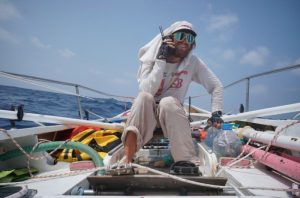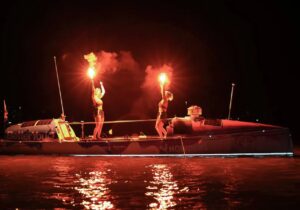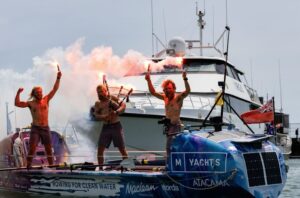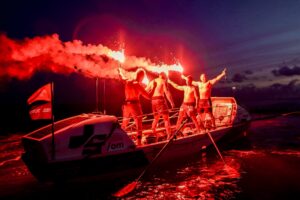Since our last ocean rowing roundup, three journeys have ended unsuccessfully. One solo rower/cyclist has begun a three-year round-the-world expedition.
Pacific Ocean
Tom Robinson: The young Australian’s Pacific row came to a sad end on Oct. 5. Robinson was only four days into the final stage of his row to his home country when he had to call for rescue.
While crossing the Bougainville Strait, a huge wave struck his boat. Water flooded the cabin, and his boat flipped. Unable to right the boat, Robinson swam out and hauled himself onto the top of the capsized boat. He tied himself to the hull, set off his EPIRB, and waited 14 hours to be rescued. A cruise ship detoured 200km to collect him.
This was supposed to be the final stage of his row from Peru to Australia. Initially, he rowed from Lima to Penrhyn where he waited out the cyclone season. He then made his way to American Samoa and finally to Vanuatu. It was from here that he started his last section on Oct. 2. Until the rescue, he was on track to become the youngest person ever to solo row the Pacific Ocean.
Atlantic Ocean
Jari Saario: The Finnish rower attempted to complete a double crossing of the Atlantic. Starting in the Canary Islands, he was going to row to Miami, but electrical issues forced him to detour to Antigua. Here, his first crossing ended on March 28. He then went back to Finland and made repairs while reassessing his route.
He eventually decided to make his second row from Newfoundland, Canada to Finland. After 75 days, he landed in Scotland. Potentially rough weather convinced him to reach the North Sea via the inland Caledonian Canal Route. But then his electrical system began to play up.
Unable to fix it, he sent the boat to London for repairs. Then he had to make a difficult decision. Should he attempt to row the North Sea back to Finland at this late and rough time of year? Many advised him against it.

Jari Saario. Photo: Instagram/Jari Sarrio
Eventually, on Sept. 29, he set off into the North Sea. Conditions forced him to keep rowing to avoid blowing off course. Some nights he barely slept. A few days into October, he commented on social media that it had been such a hard day that “tears just fall as I paddle.”
On Oct. 5, the situation became drastically worse. Waves and swells were so bad that his boat flipped during the night and was upside down for several minutes. All his equipment was drenched. Barely able to continue, he detoured to Cuxhaven, Germany and finished his row there on Oct. 7.
Back on dry land, he said, “We conquered more than we set out for. We rowed across the Atlantic and back…I am proud of all that we achieved.”
Louis Margot: On Sept. 3, Louis Margot of Switzerland started a human-powered circumnavigation of the world, rowing and cycling. Starting in Morges, Switzerland, he cycled 2,300km in 25 days to Portimao, Portugal.
He has been rowing since he was 13 and won his first Swiss Championship in 2008. He then went on to compete in the Junior World Rowing Championships for Switzerland. However, ocean rowing is new to him. After leaving university, he took up long-distance cycling.
The record for a human-powered circumnavigation is five years and 11 days. He hopes to finish in three years.
The second leg of his journey is a 10,300km row from Portugal to Costa Rica. He started rowing on Oct. 9. Sadly, it was short-lived. Margot found the first few days a struggle because of seasickness. His communication devices were also not working properly. Then the weather worsened, and forecasts predicted that he would need to be on his sea anchor for up to 10 days.
He decided to turn back to Portugal and wait for better weather. “It’s a hard blow to morale,” he commented, “but these six days at sea have taught me a lot.” He plans to restart next week, on Oct. 22.
Arctic Ocean
Matty Clarke: Matty Clarke was rowing the Northwest Passage from west to east. He began as a pair but was forced to continue solo when his partner Adam Riley injured his shoulder. He has had to make multiple repairs to his boat along the way.

Matty Clarke ends his attempt to cross the NWP. Photo: Matty Clarke/Instagram
Not long after crossing the halfway point, his electrical systems failed. This meant he would have no use of his bilge pumps or communication devices. He ended his row at the Inuit town of Gjoa Haven.






